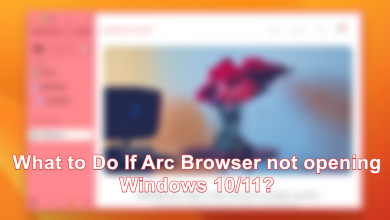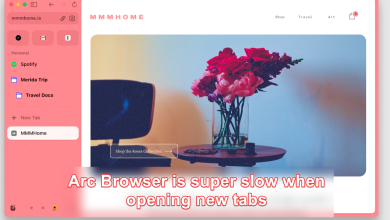Fix: Shockwave Flash Crashes in Chrome Windows 10
A lot of users have been reporting that Shockwave Flash is frequently crashing in Chrome under Windows 10 regardless of the website or type of content that is being viewed. The issue seems to be exclusive to Windows 10 and is not only limited to Insider Builds and Technical Preview builds. While some users report that this issue occurring only with the Chrome browser, others report that this is a system-wide issue, even affecting Microsoft Edge and Internet Explorer.

Past behaviour
On older Windows versions, Flash crashes like this would happen because two Flash versions were running at the same time. In addition to Chrome’s own version of Flash, most computers had another Flash installation that was pre-installed, bundled with other software or downloaded from Adobe’s website. What would happen is the two Flash versions would trip each other causing a crash and an unresponsive period of the browser.
However, this should no longer be an issue since Google Chrome got smart enough to disable itself when it detects a system-wide Flash installation. But this is only true if you have a new enough Chrome version.
Fixing the Shockwave Flash Crashes in Chrome error
If you’re currently struggling with this issue, this article will provide you with a list of effective troubleshooting steps. Below you have a list of methods that other affected users have used in order to resolve the issue. Please follow each potential fix in order until you discover a solution that fixes the Shockwave Flash Player for you. Let’s begin.
Method 1: Update Chrome to the latest version
Before you do anything else, let’s make sure that Google Chrome is smart enough to disable the built-in Flash version if it detects that there’s another system-wide Flash enabled.
Keep in mind that the older Google Chrome version would force the built-in Flash version even while the system-wide Flash was running. This would end up creating crashes, unresponsive periods and general browser instability. Since Google has fixed this glitch, updating your browser to the latest version should resolve the issue if this is causing the crash.
Here’s a quick guide on updating Chrome to the latest version:
- Open Google Chrome and click the action button (three-dot icon) in the top-right corner of the screen.
- From the action menu, go to Help and click on About Google Chrome.
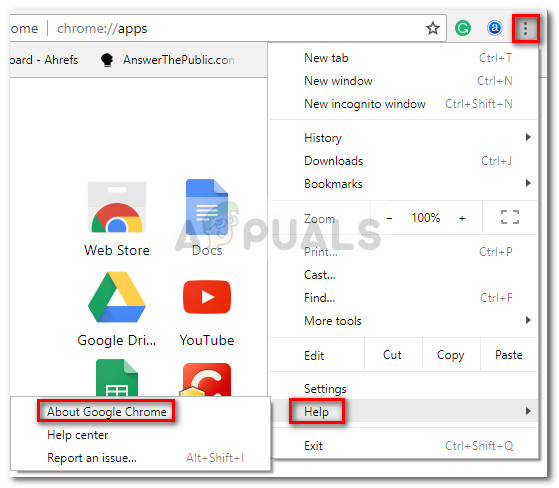
- In the Help Window, wait until the wizard checks if you have the latest available version. If you don’t follow the on-screen prompts to install the latest version.
 Note: Normally, Google Chrome should update by itself whenever a new important update is available but this behavior might get overridden by a manual setting or 3rd party app.
Note: Normally, Google Chrome should update by itself whenever a new important update is available but this behavior might get overridden by a manual setting or 3rd party app. - Once the update is complete, restart Google Chrome and see whether Shockwave Flash crashes again. If you’re still seeing the same behavior, move down to the next method below.
Method 2: Disable all extensions
Depending on what extensions you’re using, it’s entirely possible that one of your active extensions is interfering with Flash. Fortunately, it’s quite easy to test if this is your culprit – by starting Chrome with all extensions disabled.
If Google Chrome doesn’t crash or becomes unresponsive while your extensions are disabled, you can conclude that one of the extensions is causing the problem. In the event that you determine that one of the extensions is to blame for the constant crashes of Flash, we’ll proceed to systematically re-enable each extension to test which one is causing the issue.
Here’s a quick guide on disabling all extensions and figuring out which one is causing the problems with Shockwave Flash:
- Open Google Chrome and click on the action button (three-dot icon) in the top-right corner.
- Click on New Incognito Mode and use the newly opened window to test various flash content. If the crash happens again, jump straight to Method 3. If you don’t see the crash recurring while in Incognito Mode, continue with the next steps below.
- Acess the action button again (three-dot icon) and go to More tools > Extensions.
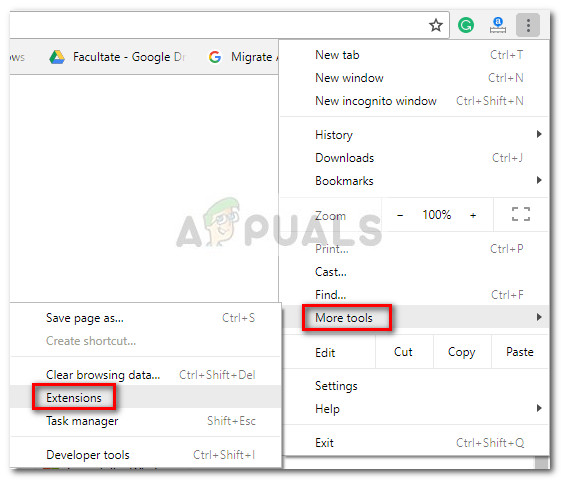
- In the Extensions tab, start by disabling every active extension. You can do this by using the toggle associated with each extension.
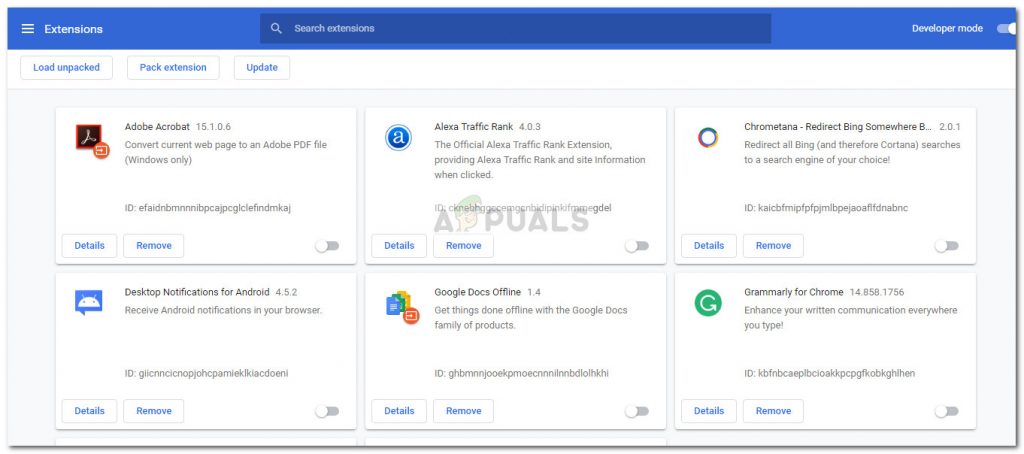
- Once all extensions are disabled, systematically re-enable each one and test for flash crashes until you manage to identify the culprit.
Method 3: Update to latest available Windows version
If you are using an insider build, you could be dealing with a glitch that is causing your Shockwave Flash to crash. A lot of users have been reporting Flash problems on builds 10130 and 10147. If you haven’t performed the latest updates available, we strongly recommend that you do and see if the issue resolves itself.
Here’s a quick guide on making sure your Windows 10 is up to date:
- Press Windows key + R to open up a Run box. Next, type or paste “ms-settings:windowsupdate” and hit Enter to open Windows Update.

- In the Windows Update screen, click the Check for Updates button and wait for the investigation to complete.
- Follow the on-screen prompts to install every pending update that is not optional. Keep in mind that if you have a lot of pending updates, your PC will restart several times. Make sure to return to the Windows Update menu to check if you don’t have any other pending updates.
- Once your Windows version is up to date, do a final reboot and check if the issue has been resolved at the next startup. If you’re still experiencing Flash crashes in Chrome browser, move down to the next method below.
Method 4: Update dedicated sound card drivers
Some users have reported that this particular Flash Shockwave clash can also be caused by an incompatibility between a dedicated soundcard and Windows 10. This occurrence is reported to mostly happen with Realtek drivers and is usually reported right after the user upgrades to Windows 10 from an older Windows version.
The fix for this particular issue is to update your audio drivers to the latest version available. As of now, most incompatibilities with Windows 10 have been fixed so you should be able to resolve the issue by making sure you have the latest sound drivers. Here’s a quick guide on how to update your dedicated sound card drivers:
- Press Windows key + R to open up a Run box. Next, type “devmgmt.msc” and hit Enter to open Device Manager.

- In Device Manager, expand the Sound, video and game controllers drop-down menu. Next, right-click on your dedicated sound card driver and choose Update Driver.
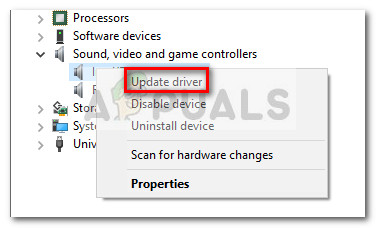
- In the next screen, click on Search automatically for updated driver software. Wait until the analysis is complete and follow the on-screen prompts to update the audio driver.
- Once the process is complete, reboot your computer and see if the issue has been resolved at the next startup.
If you’re still getting Flash crashes in Chrome, move down to the next method below.
Method 5: Changing Headphones settings
If you’re only getting Flash crashes in your browser while using headphones, you might fix the issue by changing some settings in the Sound menu. One user that has been only dealing with this issue while using a headset has managed to resolve the issue by enabling Dolby Audio and modifying the Quality Format. Here’s a quick guide on how to do this:
- Press Windows key + R to open up a Run box. Next, type “mmsys.cpl” in the Run box and hit Enter to open the Sound menu.

- In the Sound menu, go to the Playback tab, right-click on your headset and choose Properties.
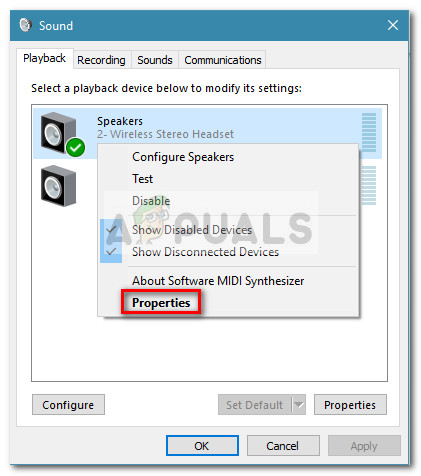
- Go to the Advanced tab and use the drop-down menu under Default Format to set the audio quality to 2 channel, 16 bit, 44100 Hz (CD Quality).
Note: If you have a Dolby Audio tab, expand it and turn the feature ON. - Hit Apply and reboot your computer to force the changes to take effect.
- At the next startup, utilize your headset normally and see if the Flash crashes in Chrome have been resolved.
If you’re still dealing with frequent Flash crashes inside Google Chrome, move down to the next method.
Method 6: Using a different browser
If you’ve come this far without a result, one final solution that will allow you to play Flash content without frequent crashes is to change the browser. But this is only true if your problem is only occurring with Google Chrome (not system-wide).
If you are prepared to trade Chrome for a more stable browser when it comes to Flash content, you can use Internet Explorer, Firefox or Opera. Experiment with these options and see which browser is closer to what you need for your web surfing experience.
In the event that you insist on using Google Chrome, move down to the final method.
Method 7: Perform a repair install
Some users have managed to resolve the issue and stop the frequent Shockwave Flash crashes in crome by reinstalling Windows. Although this is quite a drastic approach, you can limit the damage by performing a repair install. This will allow you to preserve your personal files as well as the installed applications.

